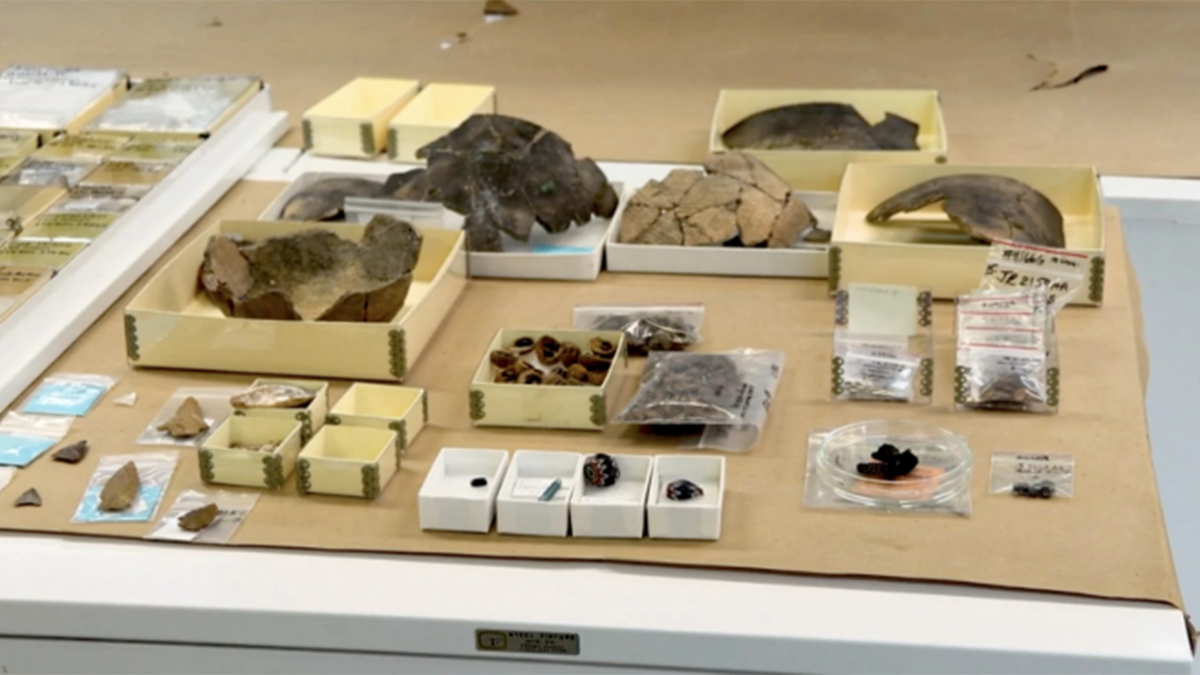Ongoing archeological work at Jamestown is exploring the complex relationship between Indigenous people and European colonists.
Today, for many Native Americans, Jamestown and James Fort has been a space that celebrated the story of colonization and European settlement. It was a place that many Indigenous people avoided.
This story was reported and written by VPM News
Ashley Spivey is Pamunkey Indian — and one of a few mid-Atlantic archaeologists with Indigenous roots.
“My mother, who is Pamunkey, did not take us to places like Jamestown or Colonial Williamsburg, because at that time, we did not see ourselves represented or reflected there,” she said. “And if we were, it was through a stereotypical, inaccurate and sometimes, quite frankly, disrespectful way. My mom wanted to shield us from that.”
Spivey is the executive director of Kenah Consulting, where she provides knowledge of Indigenous archaeology and tribal historic preservation to help protect cultural resources.
She said archeology is a tool that can help better explain Indigenous history.
“For me, as an Indigenous person who does archaeology, I look to what we refer to as the archaeological record as a document that tells us about our ancestors, our families and our histories,” Spivey said. “A lot of folks don’t really realize that Indigenous people are in this region, because we didn’t have a written language.”
Over the past 30 years, a team of archeologists has been digging through Jamestown looking for artifacts. What they’ve uncovered tells a story about colonists and the Indigenous people living in the region before and after Europeans' arrival.
The materials also capture the undeniable history of Indigenous people thriving.
The Paspahegh Indian tribe lived in the area just north of what’s now called the James River. They were part of the Powhatan Paramount Chiefdom known as Tsenacomoco. The empire stretched from the James to the Potomac River and dates back to 900 A.D.
But the archeological discoveries — including millions of pieces of tools, pottery, projectile points and beads — show Indigenous people were living and working among the colonists, and exchanging materials and knowledge with them.
“They’ve done a great job over the last 10 or 20 years recognizing the importance of the Indigenous community in Virginia,” Nansemond Chief Keith Anderson said about Jamestown.
The Nansemond tribe has had a long running relationship with Jamestown.
“There’s a very significant amount of artifacts from the Nansemond tribe that are here that have helped us really regain a sense of pride and belonging to the commonwealth,” Anderson said.
David Givens, director of archeology at Jamestown Rediscovery, has been doing archeological work at Jamestown for more than 20 years.
“Native peoples were living and sustaining the colony at times. And that’s not a story that you often hear in your history books, but we’re seeing it with the archaeology,” Givens said.
The property is managed through a public-private partnership between Preservation Virginia and the National Park Service.
The evidence of Indigenous and colonial commingling and cooperation was so clear that the organization decided to revamp its museum in 2014 to better tell Indigenous history.
“We wanted to make sure that we were telling the story in the context, that entanglements story, in a meaningful way,” Givens said.
Now that archaeology is clarifying Jamestown's story, some Native people are asking to have more input over what happens to Indigenous artifacts found in the commonwealth.
Spivey said the archeological discoveries at Jamestown are more than clues to the past.
“When you find something in the ground, like ‘an arrowhead’ we refer to them as ‘projectile points.’ That’s not just an object for study,” Spivey said. “It’s an object representing our histories, our stories and our families.”
Updated regulations of the Native American Graves Protection and Repatriation Act went into effect in January, giving federally recognized tribes more control over how Indigenous artifacts are displayed.
Several large museums, including the American Museum of Natural History in New York and the Field Museum in Chicago, closed exhibits to consult with Indigenous people about how best to present their history.
At Jamestown, Givens said, the work of interpreting history is ongoing, but there were no immediate plans to make changes to its Archaearium archaeology museum.
“Everything that we dig up, and everything at the site, we’re only stewards of that shared history,” Givens said. “It belongs to the American public, our nation, our curious visitors and the nations within our nations, the First People’s Nations.”
Anderson, who has had an informal advisory role with Jamestown Rediscovery, said the state’s federally recognized tribes should continue to be included.
“Those respective tribes [should] have a seat at the table from the onset and that the tribe’s anthropologists or scientists are invited as well to be a part of the process,” Chief Anderson said.



